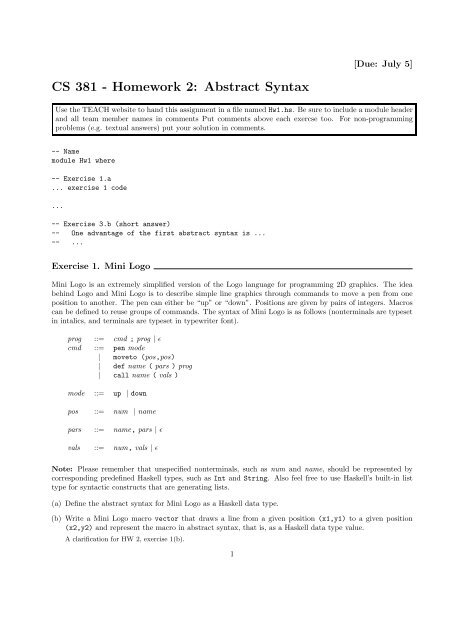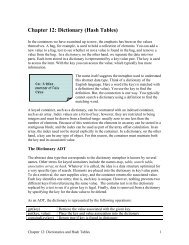CS 381 - Homework 2: Abstract Syntax - Classes
CS 381 - Homework 2: Abstract Syntax - Classes
CS 381 - Homework 2: Abstract Syntax - Classes
Create successful ePaper yourself
Turn your PDF publications into a flip-book with our unique Google optimized e-Paper software.
[Due: July 5]<br />
<strong>CS</strong> <strong>381</strong> - <strong>Homework</strong> 2: <strong>Abstract</strong> <strong>Syntax</strong><br />
Use the TEACH website to hand this assignment in a file named Hw1.hs. Be sure to include a module header<br />
and all team member names in comments Put comments above each exercse too. For non-programming<br />
problems (e.g. textual answers) put your solution in comments.<br />
-- Name<br />
module Hw1 where<br />
-- Exercise 1.a<br />
... exercise 1 code<br />
...<br />
-- Exercise 3.b (short answer)<br />
-- One advantage of the first abstract syntax is ...<br />
-- ...<br />
Exercise 1. Mini Logo<br />
Mini Logo is an extremely simplified version of the Logo language for programming 2D graphics. The idea<br />
behind Logo and Mini Logo is to describe simple line graphics through commands to move a pen from one<br />
position to another. The pen can either be “up” or “down”. Positions are given by pairs of integers. Macros<br />
can be defined to reuse groups of commands. The syntax of Mini Logo is as follows (nonterminals are typeset<br />
in intalics, and terminals are typeset in typewriter font).<br />
prog ::= cmd ; prog | ɛ<br />
cmd ::= pen mode<br />
| moveto (pos,pos)<br />
| def name ( pars ) prog<br />
| call name ( vals )<br />
mode ::= up | down<br />
pos ::= num | name<br />
pars ::= name, pars | ɛ<br />
vals ::= num, vals | ɛ<br />
Note: Please remember that unspecified nonterminals, such as num and name, should be represented by<br />
corresponding predefined Haskell types, such as Int and String. Also feel free to use Haskell’s built-in list<br />
type for syntactic constructs that are generating lists.<br />
(a) Define the abstract syntax for Mini Logo as a Haskell data type.<br />
(b) Write a Mini Logo macro vector that draws a line from a given position (x1,y1) to a given position<br />
(x2,y2) and represent the macro in abstract syntax, that is, as a Haskell data type value.<br />
A clarification for HW 2, exercise 1(b).<br />
1
<strong>CS</strong> <strong>381</strong>, Summer 2010, <strong>Homework</strong> 2 2<br />
What you should actually do is write a Mini Logo program that defines a vector macro. So the answer should have<br />
the following form.<br />
def vector (...) ...<br />
This is the textual representation in concrete syntax. Then you should write the same Mini Logo program in<br />
abstract syntax, that is, give a Haskell data type value in the following form (assuming Def is the constructor name<br />
representing the def production).<br />
vector = Def ”vector” ... ...<br />
(c) Define a Haskell function steps :: Int -> Prog that constructs a Mini Logo program which draws a<br />
stair of n steps.<br />
(1,2)<br />
(1,1)<br />
(0,0)<br />
(0,0)<br />
Results of the Mini Logo programs produced by steps 1 and steps 3.
<strong>CS</strong> <strong>381</strong>, Summer 2010, <strong>Homework</strong> 2 3<br />
Exercise 2. Digital Circuit Design Language<br />
Digital circuits can be built using the following four basic types of logical gates.<br />
1<br />
2<br />
AND<br />
1<br />
0 OR 0 XOR 0 1 NOT 0<br />
2<br />
1<br />
2<br />
The “Digital Circuits Design Language” whose syntax is shown below can be used to describe circuits built<br />
from these gates.<br />
circuit ::= gates; links<br />
gates ::= num:gate ; gates | ɛ<br />
gate ::= and | or | xor | not<br />
links ::= from num.num to num.num; links | ɛ<br />
Please note that logical gates as well as their input/output ports are identified by numbers. The inputs of<br />
a gate a numbered from top to bottom, starting from 1. The output is always numbered 0. Consider the<br />
following circuit, a half adder.<br />
This circuit can be defined by the following DiCiDL program.<br />
1:xor;<br />
2:and;<br />
from 1.1 to 2.1;<br />
from 1.2 to 2.2<br />
(a) Define the abstract syntax for the above language as a Haskell data type.<br />
(b) Represent the half adder circuit in abstract syntax, that is, as a Haskell data type value.
<strong>CS</strong> <strong>381</strong>, Summer 2010, <strong>Homework</strong> 2 4<br />
Exercise 3. Designing <strong>Abstract</strong> <strong>Syntax</strong><br />
Consider the following abstract syntax for arithmetic expressions.<br />
data Expr = N Int<br />
| Plus Expr Expr<br />
| Times Expr Expr<br />
| Neg Expr<br />
Now consider the following alternative abstract syntax. (Note: The different names have been chosen only to<br />
allow both definitions to occur within one Haskell module and have otherwise no significance. In particular,<br />
the names are irrelevant for exercise part (b).)<br />
data Op = Add | Multiply | Negate<br />
data Exp = Num Int<br />
| Apply Op [Exp]<br />
(a) Represent the expression -(3+4)*7 in the alternative abstract syntax (i.e. an Exp). Remember unary<br />
negation - binds tighter than multiplication or addition.<br />
(b) What are the advantages or disadvantages of either representation?<br />
(c) Define a function translate :: Expr -> Exp that translates expressions given in the first abstract syntax<br />
into equivalent expressions in the second abstract syntax.

















